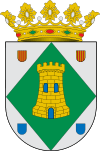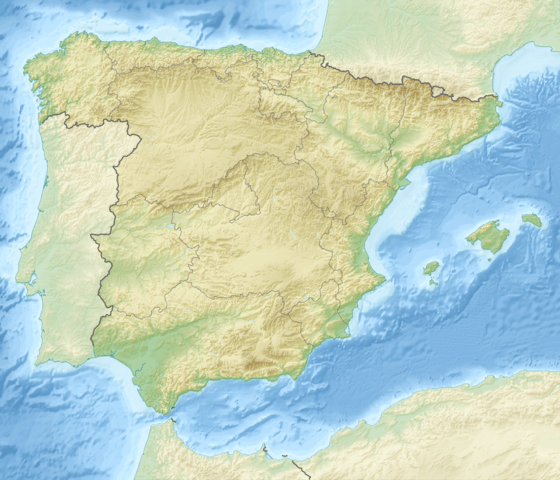Torrijo del Campo
Torrijo del Campo is a municipality located in the province of Teruel, Aragon, Spain. According to the 2018 census (INE), the municipality has a population of 447 inhabitants.
Torrijo del Campo, Spain | |
|---|---|
 Flag  Seal | |
 | |
| Coordinates: 40°50′N 1°20′W | |
| Country | Spain |
| Autonomous community | Aragon |
| Province | Teruel |
| Comarca | Jiloca |
| Area | |
| • Total | 43 km2 (17 sq mi) |
| Elevation | 923 m (3,028 ft) |
| Population (2018)[1] | |
| • Total | 447 |
| • Density | 10/km2 (27/sq mi) |
| Time zone | UTC+1 (CET) |
| • Summer (DST) | UTC+2 (CEST) |
History
It was named Torrijos between 1495 and 1646, later being renamed Torrijo from 1713 to 1797, and adding del Campo from 1834. The placename derives from Latin, and means turret, which could mean that it was a border surveillance post in the various conflicts between the Crown of Aragon and the Crown of Castile.
Torrijo belonged to the sesma of the Río Jiloca in the Community of Villages of Daroca and it was already recorded in the Archpriesthood of Daroca in 1280. It was assigned to Sobrecullida, Vereda and Corregimiento of Daroca at different times, being a village until 1711, a place in 1785 and a town belonging to the partido judicial of Calamocha since 1834.
The archaeological works carried out in the area confirmed the presence of ancient cultures, as in the case of Cerro del Moro,[2] an area that was used as an old cemetery and where some pottery has been found. This oval-shaped settlement conserves as its only remnant a hollow in the rock that was possibly used as a cistern.
Archaeological remains have also been found in the area of the Eras where fragments of Iberian pottery appeared, in the Masada area where medieval pottery was found or in the Iberian site of La Balseta. In addition, in 1996 a bronze plaque with an Iberian inscription was found on the road to Huertos Altos, which is called the Bronze of Torrijo. This finding was deposited for study at the Teruel Museum.
Other archaeological remains are the uninhabited Villaverde, an Iberian town where fragments of Roman and medieval pottery has been found.
In addition, between Torrijo and Monreal del Campo there was a medieval town called Villacadima, of which several buildings are preserved including the stone markers that delimited it and in which its name is engraved. Villacadima was a stately place, belonging to the Catalan de Ocón family, which was not subject to royal or community law. For this reason, it often served as a refuge for criminals in the area. In 1311, and after the order of King Jaime II to acquire it, it was incorporated into the Community of Villages of Daroca. There is evidence that in the fourteenth century Villacadima had already disappeared, so its terms passed to the municipality of Monreal.
Economy
After the gradual disappearance of saffron crops, which in Torrijo del Campo had great importance not only economically but also traditionally, its inhabitants mainly focus their activity on rainfed cereal agriculture and in some irrigated orchards, meadows and forest areas. Livestock farming is also relevant, where a large number of pig, sheep, beef and rabbit farms stand out. In addition, the nearby towns of Calamocha and Monreal del Campo are the job destination for Torrijanos and Torrijanas, who thus complement the family economy.
Municipal symbols
As Mayor Miguel Ángel Meléndez, the Torrijo City Council initiated a file for the adoption of a municipal coat of arms and flag that ended with the authorization by the Government of Aragon through Decree 100/1997, of June 10, to adopt them.
According to this Decree, the coat of arms should have the following form: «a rectangular base with a circular base, which brings, from sinople, a golden tower, mabled with saber and clarified with azure; silver dress, loaded on top of two escutcheons with the Royal Sign of Aragon and on the bottom with two others, full azure. The bell, open Royal Crown".[3]
For its part, the flag had to be “blue cloth, 2/3 proportion, with an escutcheon of the Royal Sign of Aragon at each of its corners; to the shaft a horizontal strip of 1/3 the length of the cloth with a yellow tower, with the door and the green windows placed inside a white rhombus".[4]
Heritage
- Catholic parish church of San Pedro, 18th century.
- Hermitage of San Fabián and San Sebastián. Destroyed the old of the XV century, the modern of the XX century.
- Hermitage of Santa Bárbara, from the early 20th century.
Illustrious Neighbors
Among its neighbors we find illustrious figures such as Francisco Cabello Rubio, Aragonese politician and jurist who held the position of Civil Governor in the provinces of Teruel, Castellón and Valencia until in 1840 he was appointed Minister of the Interior.
Also in the political area stand out Gabriel Campo Arpa, whose son José Campo Pérez was Mayor of Valencia. José was named Marqués de Campo by Alfonso XIII in 1875. Gabriel Campo Arpa's brother, Pedro Campo Arpa, was a military man who participated with the rank of Colonel in the signing of the final act of the War of Independence of El Salvador. Her son Rafael Campo Pomar became president of El Salvador.
Another illustrious neighbor of Torrijo del Campo is Fray León Villuendas Polo who was a professor in Rome of Exegesis, Attorney General in the Holy Land, Definitor General and President of the Pontifical Athenaeum of Rome. In 1944 he was appointed Bishop of Teruel.
Julián Torrijo Sánchez, another neighbor of Torrijo, was beatified in 2001 by Pope Juan Pablo II.
We also find singers of the stature of José María Julve Terrado and Jesús Benito Rubio or the blacksmith Antonio Edo Martín whose handicrafts have been exhibited in various exhibitions held at the Museum of the Teruel in addition to being chosen in Barcelona for the exhibition of "Catalan Artists in Forge".
Also a descendant of Torrijo del Campo is the swimmer Teo Edo Farré, Olympic in Sydney 2000 where he got 24th place in the 1500 meters freestyle.
Within the academic world, we find Calixto Plumed Moreno, professor at the University School of Nursing and Physiotherapy "San Juan de Dios"; Julio Palacios Martínez, prominent scientist member of the Royal Spanish Society of Physics and Chemistry and the Royal Spanish Academy; Pascual Rubio, professor at the Department of Geography and Spatial Planning at the University of Zaragoza; and Francisco Gascón Latasa, professor of Physics at the University of Seville.
References
- Municipal Register of Spain 2018. National Statistics Institute.
- Cerro del Moro
- http://www.boa.aragon.es/cgi-bin/EBOA/BRSCGI?CMD=VERDOC&BASE=BZHT&PIECE=BOLE&DOCR=38448&SEC=BUSQUEDA_AVANZADA&RNG=10&SORT=&SEPARADOR=&&SECC-C=BOA+O+ACUERDOS
- http://www.boa.aragon.es/cgi-bin/EBOA/BRSCGI?CMD=VERDOC&BASE=BZHT&PIECE=BOLE&DOCR=38448&SEC=BUSQUEDA_AVANZADA&RNG=10&SORT=&SEPARADOR=&&SECC-C=BOA+O+ACUERDOS